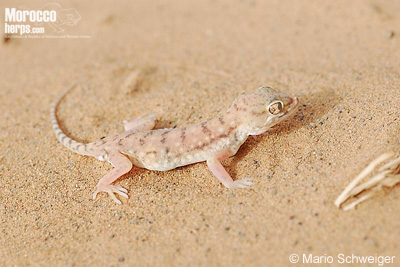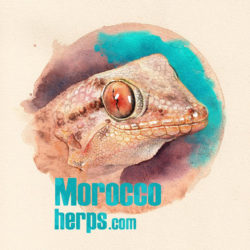Northern Elegant Gecko
Stenodactylus mauritanicus Guichenot, 1850
Por Gabriel Martínez del Mármol Marín
Updated: 23/12/2012
Taxonomy: Gekkota | Geckonidae | Stenodactylus | Stenodactylus mauritanicus


 Stenodactylus mauritanicus
Stenodactylus mauritanicus
Distribution map of
Stenodactylus mauritanicus
in Morocco.
Photo gallery: 22 photographies. [ENTRAR]
Phylogenetic frame
Traditionally it was considered a subspecies of Stenodactylus sthenodactylus (Lichtenstein, 1823), it was elevated to species by Baha el Din (2006) due to morphological differences and the existence of several localities where both forms live in sympathy, which seems to have been recently accepted by the authors age (de Pous et al., 2010; Fujita and Papenfuss, 2011) and has recently been confirmed by genetic analysis (Mettalinou et al., 2012).
Description
Stenodactylus mauritanicus is a small gecko with a known maximum snout to vent lengh of 4.3 cm.
The head is large, well differentiated from the body and the eyes stand out: large and with a spectacular design. These are surrounded by a light colored line that thickens in the part closest to the snout. This is short and rounded, and in its front part the two nostrils are located, which are not in contact with the rostral scale and protrude slightly.

The body is short and relatively thick. The dorsal scales are rough and granular, mixed with some slightly elongated scales. The ventral scales are uniform and slightly less elongated than the dorsal ones. It has short, thick limbs and fingers. The tail is thick and relatively short in proportion to the snout-vent length (tail / snout-vent length ratio = 0.62; Baha el Din, 2006).
The coloration is very variable. On the head and dorsal area it is composed of grayish, reddish, pink, beige tones … dotted with light circular and other dark markings that can be rounded or very frequently merge forming very elegant bands and designs that give the name to this gecko and that can be bordered with a darker shade. The ventral part is white. The unregenerate tail has a design and color similar to the dorsal part.


The most similar species in Morocco are Stenodactylus petrii and Stenodactylus sthenodactylus. The 3 can be differenciated according to the following table:
| S. petrii | S. sthenodactylus | S. mauritanicus | |
|---|---|---|---|
| Tail | thin | thick and relatively large (average tail/SVL of 0,88) | thick and relatively short (average tail/SVL of 0,62) |
| Cloacal tubers | in several rows and protuding strongly at the base of the tail | almost always in a row and without protuding excessively | almost always in a row and without protuding excessively |
| Rows of transverse subdigital scales | 3-5 | 1 | 1 |
| Nasal area | almost always stands out strongly | only slightly protuding | |
| Snout | almost always convace in profile | almost always convex in profile | |
| Maximum Snout-Vent Lenght (SVL) | Over 4,5 cm | Less than 4,5 cm | |
| Dorsal scales | Very smooth and homogeneous | rough and a bit heterogeneous | |
| Preanal pores | only in some populations | missing |
Table based in Schleich et al., 1996; Geniez et al., 2004 and Baha el Din, 2006.
Ecology and habits
Eminently land and night gecko. Most encounters with this specis occur in spring, in the early hours of the night. During the day it hides under stones or in burrows (Bons & Geniez, 1996).
As a defensive mechanism, it can release the tail (Baha el Din, 2006).
Distribution, habitat and abundance
It inhabits the arid and Saharan zones of the south and east of the High Atlas. In Western Sahara it occupies the north, reaching Mauritania from the coast (Bons & Geniez, 1996; Geniez et al., 2004; P. Geniez, com. pers.).

It has been found in numerous habitats: coastal dunes (Tarfaya, Aoreora…), sandy areas alternated with rocks (Fask), earthy steppes with an abundance of mammal galleries and Euphorbia officinarum ssp. echinus (Guelmim, Sidi Ifni…) or strictly rocky areas such as hammadas and reg (Assa, Tata…).
It´s considered a sparse species in Morocco and Western Sahara (Bons & Geniez, 1996), although in some parts of its distribution it is locally abundant. It present the same conservation problems as most reptiles in the study area, having been found dropped in water holes and very frequently in roads, where being a slow animal, it must be frequently run over.
Bibliography
- Baha el Din, S. 2006. A guide to the reptiles and amphibians of Egypt. The American University in Cairo Press, Cairo. 359 pp.
- Bons, J. & Geniez, P. 1996. Anfibios y Reptiles de Marruecos (Incluido Sahara Occidentales). Atlas Biogeográfico. Asociación Herpetológica Española. Barcelona. 319 pp
- de Pous, P.E.; Beukema, W.; Weterings, M.; Dummer, I. & Geniez, P. 2010. Area prioritization and performance evaluation of the conservation area network for the Moroccan herpetofauna: a preliminary assessment. Biodiversity and Conservation 20(1): 89-118
- Fujita, M.K. & Papenfuss, T.J. 2011. Molecular systematics of Stenodactylus (Geckonidae), an Afro-Arabian gecko species complex. Molecular Phylogenetics and Evolution, 58: 71-75.
- Geniez, P.; Mateo, J.A.; Geniez, M. & Pether, J. 2004. The amphibians and reptiles of the Western Sahara (former Spanish Sahara) and adjacent regions. Edition Chimaira, Frankfurt, 228 pp.
- Metallinou, M.;Arnold, E.N.; Crochet, P.A.; Geniez, P.; Brito, J.C.; Lymberakis, P.; Baha El Din, S.; Sindaco, R.; Robinson, M. & Carranza, S. 2012. Conquering the Sahara and Arabian deserts: systematics and biogeography of Stenodactylus geckos (Reptilia: Gekkonidae). BMC Evolutionary Biology, 12.
- Pleguezuelos, J.M.; Fariña, B.; Mateo, J.A. & Geniez, P. 2004. Nuevos datos sobre los anfibios y reptiles de Mauritania y el Sáhara Occidental. Bol. Asoc. Herpetol. Esp., 15 (2): 76-80
- Schleich, H.H., Kästle, W. & Kabisch, K. 1996. Amphibians and Reptiles of North Africa. Biology, Systematics, Field Guide. Koeltz Scientific Books. 630 pp.
To cite this species page:
Gabriel Martínez del Mármol Marín (2012): Stenodactylus mauritanicus Guichenot, 1850. En: Martínez, G., León, R., Jiménez-Robles, O., González De la Vega, J. P., Gabari, V., Rebollo, B., Sánchez-Tójar, A., Fernández-Cardenete, J. R., Gállego, J. (Eds.). Moroccoherps. Anfibios y Reptiles de Marruecos y Sahara Occidental. Disponible en www.moroccoherps.com/ficha/Stenodactylus_mauritanicus/. Versión 23/12/2012.
To cite www.morocoherps.com as a whole:
Martínez, G., León, R., Jiménez-Robles, O., González De la Vega, J.P., Gabari, V., Rebollo, B., Sánchez-Tójar, A., Fernández-Cardenete, J.R., Gállego, J. (Eds.). Moroccoherps. Anfibios y Reptiles de Marruecos y Sahara Occidental. Disponible en www.moroccoherps.com.

